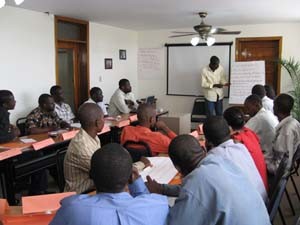
Faced with rapid growth and the limited availability of qualified human resources, Haiti’s microfinance industry needed access to sustainable microfinance training services.
With USAID support, the National Association of Microfinance Institutions in Haiti launched a new training center, marking a major milestone for the country’s microfinance sector. The association works to improve the professionalism of its 17 microfinance institution members, which provide financial services to microentrepreneurs not served by traditional financial institutions.
Professional trainer Frantz Elyzée said, “The center emphasizes not only best practice theory, but practice, and has increased the management capacity and rigor within Haiti’s microfinance sector.”
The training center offers a broad variety of services, including basic courses in microfinance, training of trainers’ workshops, and other courses that support the professional development of those working in microfinance. It also provides trainings tailored to the needs of individual microfinance institutions. Since its launch, the training center based in the capital, Port-au-Prince, has delivered 33 trainings to 373 participants. In an effort to reach rural microfinance practitioners, trainings will also be conducted in regional centers.
Training participant Jacob Hyacinth, portfolio supervisor at the Intermediary Technological Group of Haiti, said that he learned invaluable lessons in the courses he has taken at the center, particularly about portfolio management and supervision. He said the center “improves the ability of [microfinance institution] employees to do their job, thereby improving results across the sector.”
USAID continues to maintain and strengthen its commitment to microfinance development through sharing best practices with Haitian microfinance institutions. It has supported almost 4,000 participants in over 200 microfinance training events in Haiti.







Comment
Make a general inquiry or suggest an improvement.